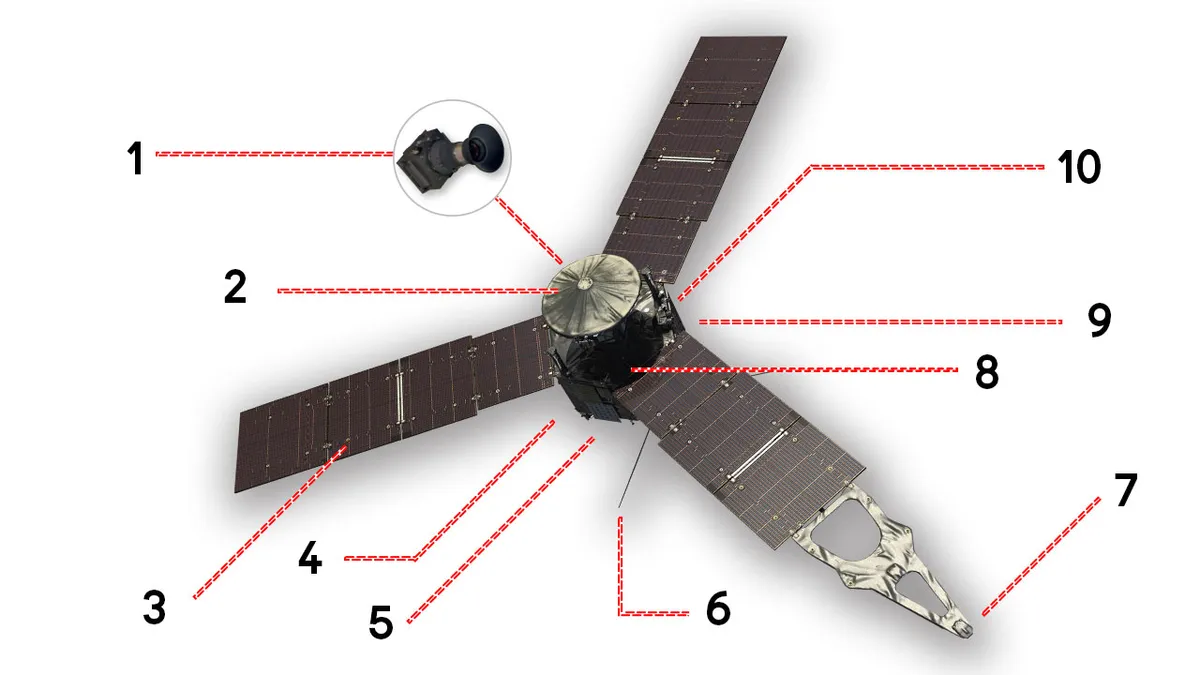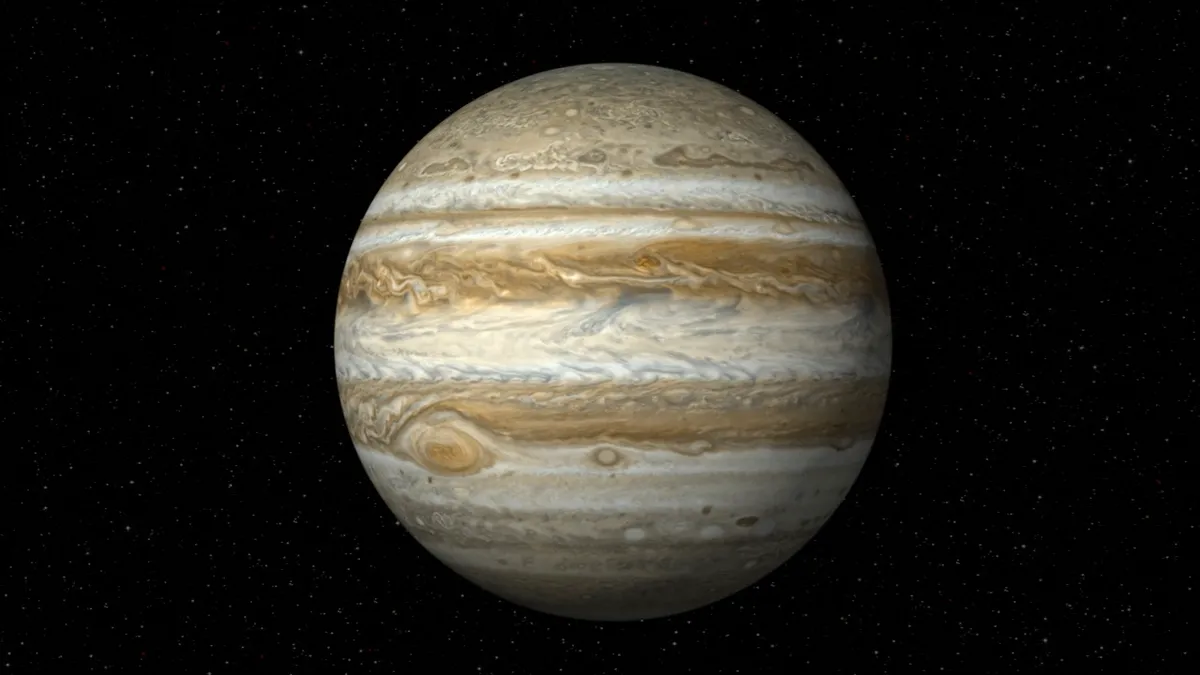On 4 July 2016, NASA’s Juno spacecraft will complete its 2.8 billion-kilometre journey to the king of the Solar System: Jupiter. For centuries the gas giant has remained a mystery, shrouded in a thick atmosphere of hydrogen and helium. But now Juno will look beyond the upper layers, right into the planet’s heart.
Juno will map the gravitational and magnetic structure of the planet, allowing researchers to test theories about how its atmospheric gases behave under the extreme pressure of Jupiter’s interior. Once Jupiter’s current construction is known, it will then be possible to work out how, when and potentially where in the Solar System the planet first formed.
The NASA mission launched into space from Cape Canaveral on 5 August 2011 aboard an Atlas V rocket, but this alone could not deliver enough thrust to reach Jupiter. On 9 October 2013 the spacecraft performed a slingshot around the Earth, using our planet’s gravity to accelerate to a final speed of 11km/s.
Once the craft arrives, Juno will perform 37 highly elliptical orbits over the planet’s poles. Its path will pass less than 5,000km above the upper clouds before swinging out to a distance of millions of kilometres and back over the course of 14 days.
Once its mission is done, the probe will be deorbited in 2018, burning up in Jupiter’s atmosphere to avoid any contamination of its moons – there are over 60 of them – which are thought to be our best chance of finding life outside our planet.
Jovian wonder
With a diameter of 140,000km and the mass of 318 Earths, Jupiter dominates our Solar System. In fact, its gravitational influence is so enormous that it affects the orbits of all the planets. It is thought that the planets of the Solar System originally formed in a slightly different configuration, but Jupiter’s huge mass upset the gravitational balance, causing it and Saturn to migrate inwards, while Neptune was flung further out in the Solar System. And that’s why Juno’s mission is so important – it is impossible to understand how our planetary system formed without knowing more about this colossus.
But our current understanding of Jupiter is limited. So far, all we have been able to see is the top few hundred kilometres of the atmosphere. Here, the planet has remained remarkably stable; the striped cream and brown bands that ring Jupiter have barely shifted in latitude during the centuries we have been observing the planet.
No one knows what keeps these bands in motion, how deep they go, what causes their colouring or what’s behind the great vortices that periodically appear within them. However, by peering through the clouds, Juno will finally allow us to answer at least some of these questions.
By measuring the gravitational field of Jupiter, researchers will be able to find areas of high density deep within the planet, and discovering the subtleties of the magnetic field will give an insight into the workings of the inner core. Together with other measurements of the surface layers, Juno will unveil the structures hidden beneath the clouds of the Solar System’s biggest enigma.
Juno’s Jupiter-studying toolkit

1
JUNOCAM
The only camera on the craft, JunoCam, will take colour images of the planet. However, the task of choosing what targets to photograph and processing the final images will be done by the public. Go to missionjuno.swri.edu/junocam to get involved.
2
GRAVITY SCIENCE
Massive structures within Jupiter create fluctuations in the planet’s gravitational field that will pull on Juno as it orbits, altering its speed. Gravity Science will measure these velocity changes, creating a gravity map from the readings.
3
SOLAR PANELS
Juno will be the most distant spacecraft to be powered by solar energy. As Jupiter receives 25 times less sunlight than the Earth, it requires three 2.65 x 8.9m solar panels to generate the 450W needed to power Juno.
4
MICROWAVE RADIOMETER (MWR)
By measuring the microwave emissions from Jupiter, the MWR will discern the thermal profile of Jupiter’s atmosphere, helping to interpret how gas circulates on the planet.
5
WAVES
The WAVES instrument will measure radio waves in the magnetosphere to investigate the interactions between Jupiter’s magnetic field and its atmosphere.
6
MAGNETOMETER
Juno’s Magnetometer will create a map of the planet’s magnetosphere by measuring the magnetic field’s strength and direction all around Jupiter. The sensors are placed on a 3.6m boom to avoid interference from the craft’s own electronics.
7
JOVIAN AURORAL DISTRIBUTION EXPERIMENT (JADE)
The three JADE detectors will detect the particles and ions caught in Jupiter’s magnetic field that cause the aurora.
8
RADIATION VAULT
The high levels of radiation around Jupiter would rapidly destroy most electronics. The craft’s sensitive systems have been encased in a 1cm-thick titanium radiation vault to protect them.
9
JOVIAN INFRARED AURORAL MAPPER (JIRAM) (located on underside of craft)
As well as imaging the aurora in the infrared, JIRAM will able to measure the thermal output of Jupiter’s upper layers and detect how much methane, water, ammonia and phosphine are present.
What willJuno be investigating?

VORTICES:Caught in Jupiter’s light-coloured zones are rotating vortices measuring thousands of kilometres across. These storms can last from as little as a few days to years or even centuries. Juno will look deep into their depths by imaging them in the infrared.
COMPOSITION:Though much of Jupiter is hydrogen (90 per cent) and helium (10 per cent), Juno will determine the levels of trace gases such as ammonia and water. Jupiter’s atmosphere has remained mostly unchanged since its formation, so learning its composition will tell us much about the primordial Solar System that created it.
RINGS:Jupiter is surrounded by faint dusty rings, believed to be material ejected from some of its moons.
MAGNETOSPHERE:Jupiter’s magnetic field, or magnetosphere, is one of the largest structures in the Solar System, extending three million kilometres around the gas giant. It’s powered by electric currents deep in the interior, but Juno’s magnetic map will determine if it is a solid core or the motion of highly pressurised ‘metallic’ hydrogen that generates these currents.
ATMOSPHERE:There is disagreement as to whether Jupiter’s upper layers sit over a stable core, or if there is no clear boundary and the two mix together freely. Juno’s gravity maps will help detect which structure exists.
CORE:It’s uncertain whether Jupiter formed from a collapsing cloud of gas, like a star, or if its atmosphere coalesced around a solid core. Studying the planet’s gravity profile will uncover whether such a core exists.
GREAT RED SPOT:Jupiter’s largest storm, the Great Red Spot, is big enough to swallow the Earth three times over, yet the force driving it is unknown. Juno’s gravity measurements will allow researchers to find out how deep the maelstrom extends, hopefully determining the source of its energy.
BELTS AND ZONES:Moving in opposite directions, the cream coloured zones and darker brown belts are separated by fast-flowing winds, called jets. Juno will attempt to discover what keeps the belts in motion.
AURORA:Like the Earth, Jupiter has aurora. Particles become caught in the magnetic field and then collide with the atmosphere, emitting light. On Jupiter though, the aurora are most vibrant at ultraviolet wavelengths. Several of Juno’s instruments will study the phenomena.
- This article first appeared in theJulyissue ofBBC Science Focusmagazine as part of a space Q&A special.
Follow Science Focus onTwitter,Facebook, Instagramand Flipboard
